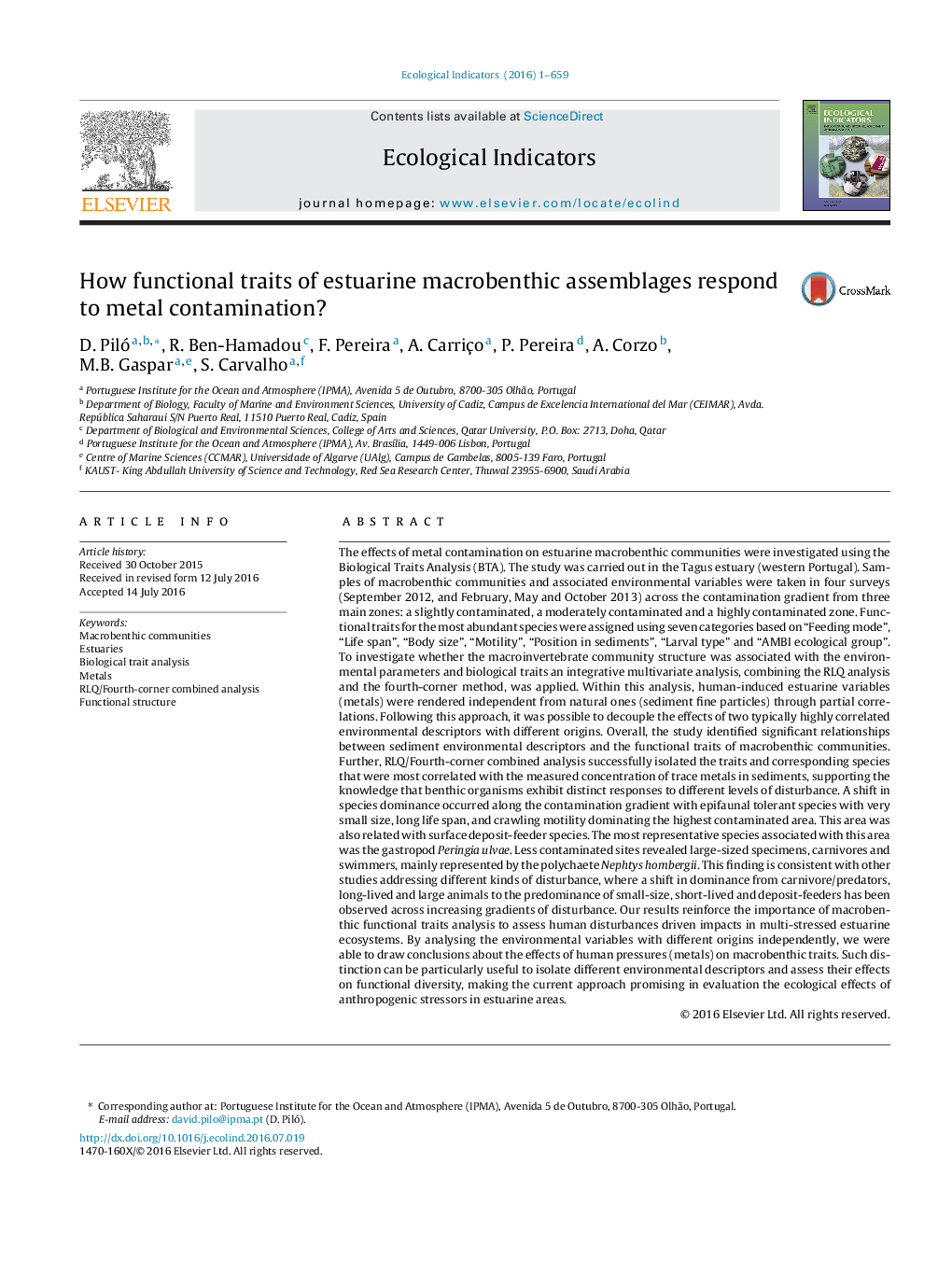| کد مقاله | کد نشریه | سال انتشار | مقاله انگلیسی | نسخه تمام متن |
|---|---|---|---|---|
| 6293026 | 1617131 | 2016 | 15 صفحه PDF | دانلود رایگان |
عنوان انگلیسی مقاله ISI
How functional traits of estuarine macrobenthic assemblages respond to metal contamination?
ترجمه فارسی عنوان
چطور صفات کاربردی مجموعه های ماکروبنتوزی دریایی پاسخ به آلودگی فلزات است؟
دانلود مقاله + سفارش ترجمه
دانلود مقاله ISI انگلیسی
رایگان برای ایرانیان
کلمات کلیدی
موضوعات مرتبط
علوم زیستی و بیوفناوری
علوم کشاورزی و بیولوژیک
بوم شناسی، تکامل، رفتار و سامانه شناسی
چکیده انگلیسی
The effects of metal contamination on estuarine macrobenthic communities were investigated using the Biological Traits Analysis (BTA). The study was carried out in the Tagus estuary (western Portugal). Samples of macrobenthic communities and associated environmental variables were taken in four surveys (September 2012, and February, May and October 2013) across the contamination gradient from three main zones: a slightly contaminated, a moderately contaminated and a highly contaminated zone. Functional traits for the most abundant species were assigned using seven categories based on “Feeding mode”, “Life span”, “Body size”, “Motility”, “Position in sediments”, “Larval type” and “AMBI ecological group”. To investigate whether the macroinvertebrate community structure was associated with the environmental parameters and biological traits an integrative multivariate analysis, combining the RLQ analysis and the fourth-corner method, was applied. Within this analysis, human-induced estuarine variables (metals) were rendered independent from natural ones (sediment fine particles) through partial correlations. Following this approach, it was possible to decouple the effects of two typically highly correlated environmental descriptors with different origins. Overall, the study identified significant relationships between sediment environmental descriptors and the functional traits of macrobenthic communities. Further, RLQ/Fourth-corner combined analysis successfully isolated the traits and corresponding species that were most correlated with the measured concentration of trace metals in sediments, supporting the knowledge that benthic organisms exhibit distinct responses to different levels of disturbance. A shift in species dominance occurred along the contamination gradient with epifaunal tolerant species with very small size, long life span, and crawling motility dominating the highest contaminated area. This area was also related with surface deposit-feeder species. The most representative species associated with this area was the gastropod Peringia ulvae. Less contaminated sites revealed large-sized specimens, carnivores and swimmers, mainly represented by the polychaete Nephtys hombergii. This finding is consistent with other studies addressing different kinds of disturbance, where a shift in dominance from carnivore/predators, long-lived and large animals to the predominance of small-size, short-lived and deposit-feeders has been observed across increasing gradients of disturbance. Our results reinforce the importance of macrobenthic functional traits analysis to assess human disturbances driven impacts in multi-stressed estuarine ecosystems. By analysing the environmental variables with different origins independently, we were able to draw conclusions about the effects of human pressures (metals) on macrobenthic traits. Such distinction can be particularly useful to isolate different environmental descriptors and assess their effects on functional diversity, making the current approach promising in evaluation the ecological effects of anthropogenic stressors in estuarine areas.
ناشر
Database: Elsevier - ScienceDirect (ساینس دایرکت)
Journal: Ecological Indicators - Volume 71, December 2016, Pages 645-659
Journal: Ecological Indicators - Volume 71, December 2016, Pages 645-659
نویسندگان
D. Piló, R. Ben-Hamadou, F. Pereira, A. Carriço, P. Pereira, A. Corzo, M.B. Gaspar, S. Carvalho,
